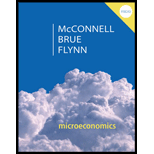
Concept explainers
Explicit and implicit cost with example.
Explanation of Solution
Explicit costs are the payments made to the resources in order to attract the resource from other uses. For example, wages to the employees, price for the inputs.
Implicit cost is the given up activity in order to take up the other activity. For example, the owner of the firm has to give up the salary he could earn by getting employed in some other firm, in order to manage his own firm. The
The explicit cost of attending college includes all the costs incurred such as college fee, tuition fee, cost of books and other stationeries. This also includes the cost of transportation.
The implicit cost that is involved for the person who go to college is the chance that he loss of getting employed and earn some income.
Concept introduction:
Explicit cost: Explicit cost refers to a direct cost given by the firm to others in the process of running business such as, wages, rents, materials etc. Thus, fixed cost and variable cost are included in the explicit.
Implicit costs: An implicit cost refers to any costs that has previously incurred but are not initially shown or reported as separate expenditures. It refers to an opportunity costthat arises when a firm allocates internal resources.
Want to see more full solutions like this?
Chapter 9 Solutions
Microeconomics: Principles, Problems, & Policies (McGraw-Hill Series in Economics)
- ??!!arrow_forward. What the heck is this GDP thingy? It is Thursday afternoon, just a few days before the holiday season starts in your region, and you decided to visit your uncle Chao who owns a local delivery company. While sitting in the living room watching the evening news with your uncle, you heard the news reporter stating the following with an optimistic tone: "According to recent studies, gross domestic product (GDP) is rising due to an increase in consumer spending. The increase in spending was due to an increase in consumer confidence because the job market has shown a positive increase in both employment and income." Immediately, your uncle Chao looked at you with some confusion on his face and asked: What the heck is GDP, and why does the news dude seem excited about its increase? Does this “good” change in this GDP thingy have any effect on my delivery business? How? Do I need to do something different to prepare for the rise in GDP? How?arrow_forward3. I need people who don’t want me! As an operations manager at a factory that produces manual tools, you were tasked with preparing a new site for expansion. The plan is to start production in the new location within 6 months from the current date. The new location requires 100 workers to operate fully. The workers you need don’t require any form of education or special skills because the tasks at the factory are simple and straightforward. In other words, you typically hire lower-skilled workers. In recent years, your company has been having problems finding workers who meet those criteria because the demand for them is so high. While sitting in your office, your teammate, Alejandra, walked to your office and said, "Have you heard the recent news about the economy? They said that investment has declined, and government spending has declined too. They also said that GDP is expected to shrink in the next 6 to 10 months. I wonder what is next." Then, she looked at you and said: How…arrow_forward
- X Apex Learning Courses public activity 003002 assessment K! Kahoot! 11.3.2 Quiz: Specialization Question 5 of 10 Which term describes a business's decision to focus on producing a small number of products? A. Opportunity cost B. Specialization C. Voluntary exchange D. Self-sufficiency PREVIOUS SUBMITarrow_forwardApex Learning Apex Learning Courses leaming.com/public/activity/1003002/assessment QQuizlet K! Kahoot! 1.3.2 Quiz: Specialization Question 5 of 10 Which term describes a business's decision to focus on producing a small number of products? OO A. Opportunity cost B. Specialization C. Voluntary exchange D. Self-sufficiency PREVIOUS SUBMITarrow_forwardnot use ai pleasearrow_forward

 Essentials of Economics (MindTap Course List)EconomicsISBN:9781337091992Author:N. Gregory MankiwPublisher:Cengage Learning
Essentials of Economics (MindTap Course List)EconomicsISBN:9781337091992Author:N. Gregory MankiwPublisher:Cengage Learning Principles of Economics 2eEconomicsISBN:9781947172364Author:Steven A. Greenlaw; David ShapiroPublisher:OpenStax
Principles of Economics 2eEconomicsISBN:9781947172364Author:Steven A. Greenlaw; David ShapiroPublisher:OpenStax Microeconomics: Principles & PolicyEconomicsISBN:9781337794992Author:William J. Baumol, Alan S. Blinder, John L. SolowPublisher:Cengage Learning
Microeconomics: Principles & PolicyEconomicsISBN:9781337794992Author:William J. Baumol, Alan S. Blinder, John L. SolowPublisher:Cengage Learning Managerial Economics: Applications, Strategies an...EconomicsISBN:9781305506381Author:James R. McGuigan, R. Charles Moyer, Frederick H.deB. HarrisPublisher:Cengage Learning
Managerial Economics: Applications, Strategies an...EconomicsISBN:9781305506381Author:James R. McGuigan, R. Charles Moyer, Frederick H.deB. HarrisPublisher:Cengage Learning





